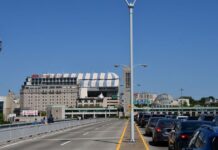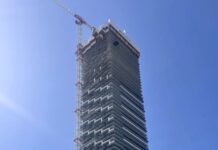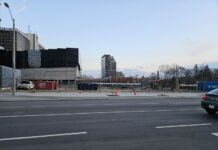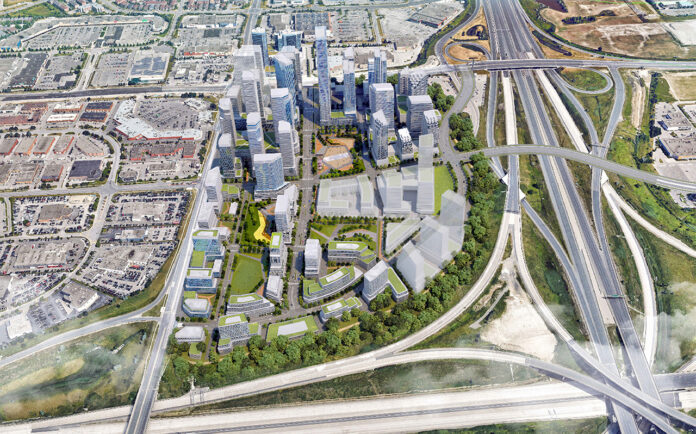Anyone familiar with driving the 400 north of Toronto will recognize the Colossus Centre, an impressively large entertainment and shopping complex best known for its iconic film complex topped by a flying saucer. Now, RioCan REIT has filed an official plan change application with the City of Vaughan for the 61.7 acre property, proposing to convert it into a mixed-use condominium with new parkland, offices, retail and entertainment options.
A look at what the Colossus redevelopment could offer, image courtesy of RioCan
The redevelopment would be a gradual, long-term intensification that would achieve urban planning goals, including increasing housing supply and affordability, providing a strengthened public space, and transforming it into a compact and urban design with strong links to existing and planned transport infrastructure.
The master plan, designed by Hariri Pontarini Architects, consists of 25 buildings ranging from 8 to 55 floors and proposes a total gross floor area (GFA) of 938,322 m², which would include 58,131 m² non-residential GFA, 880,191 m² residential GFA and 97,766 m² parkland in the form of three large parks and a multi-purpose path as well as approx. 13,000 residential units.
Presentation of the proposal within the master plan, image courtesy of RioCan
Andrew Duncan, RioCan’s vice president, development engineering, told UrbanToronto, “The apartments will likely include a mix of condominiums and rentals. As we go through the planning process, our plan is to respond to the needs of the market and what the best outcome is not only for the community itself, but for our shareholders as well.”
The Colossus site has a long history as an entertainment hub for the town of Vaughan. The current cinema was preceded by the 400 Drive-In, which opened nearly 70 years ago in 1954 with a single screen and later expanded to three screens in 1978. In its heyday, the drive-in cinema offered space for over 1,300 vehicles. In 1997, the 400 Drive-In Theater closed to make way for the cineplex theaters we all know today.
“We are in the early stages of planning this redevelopment and Cineplex is a key tenant for us and the community,” said Duncan. “This application is very dense and it will take quite a while to go through and we will be working directly with Cineplex. The current plan is to keep them on the site long-term by moving them and gradually developing them.”
In addition to the movie theater and surrounding retail stores currently on the site, a standalone Costco store is another factor in the redevelopment. “We don’t own the Costco lands,” Duncan said. “They own their own land and we worked with them in applying for this project to ensure our two individual plans were integrated. They are in the process of reviewing permits for their property, but for now we think your plan is to stay put.”
The Petro-Canada gas station on the northwest corner of the site is also not owned by RioCan, but was also included and considered in the master plan design and is in fact the site of the first phase of the project, which would occupy nearly a million square feet of land at the Continued at the corner of Highway 7 and Weston Road.
Breakdown of the lands at the Colossus site, image from the handover to the city
The expansive campus is surrounded by a collection of major roads, with Highway 7 to the north, Weston Road to the west, Highway 400 to the east, and Highway 407 and adjacent Costco lands to the south. On the east side of Highway 400 is the Vaughan Metropolitan Center (VMC), the new downtown area of the city of Vaughan. VMC is well connected to key points in the cities of Vaughan and Toronto via its TTC subway station. The VMC includes a growing number of residential, mixed-use, office and transit-aware developments and is separated from the Colossus site by 1.2 km, with the Colossus site approximately 1.6 km from the VMC subway station itself is removed.
Since they would be separated by a main road, potential residents would have to find a way to get to the VMC.
“One of the things we’ve been considering is the work that the city and province are doing on a secondary flyover over the 400 that will go into the southern portion of the VMC,” Duncan said. “So there will likely be a variety of options for residents on this side of the site to get to the VMC not just by vehicle, but also by bike or on foot.” This would be in addition to increased service along VIVA Highway 7 Rapidway route currently serving the subway station.
Overpass visible over the 400 Highway to the VMC, image courtesy of RioCan
“Our goal with development would be to provide residents with options for not having a car when they don’t need one,” Duncan said, “but we also want to recognize that people in this area may also need a car of their own.” Work or play, so we don’t let that opportunity pass us by either.”
A street and block network would be created to support pedestrian movement and create a seamless experience of walking through the new community. This would be accomplished by adding all new public and private roads that would be designed with sidewalks on either side.
New roads, paths and lanes planned for the Colossus development, image from city filing
Pedestrian lanes would also be created to prioritize pedestrian activity along a 20 meter wide east-west spine in the northern area of the development. The lanes would be primarily a non-car area, encouraging outdoor activities and further enlivened by lining it with retail.
Image courtesy of RioCan
Finally, it is suggested that the development also includes more than the 10% of the land required by the city as parking space. In fact, 20% of the property is earmarked for parking space, divided into three separate parks on the property and a multipurpose trail. The trail would make up 12.5% of the parkland.
While two parks are proposed for the southern portion of the property, the largest park – Colossus Park – would be located in the northern portion of the development and would have an area of 12,135 sqm. Colossus Park is designed to support the community’s daily recreation and to host larger programmatic events such as market events or festivals. The remaining 7.5% of the outdoor space is proposed within POPS, which would include the stables, in addition to a boardwalk/linear city park proposed along Famous Avenue.
Colossus Park, the community’s central feature, image courtesy of RioCan
Currently, RioCan is focused on changing the official plan followed by applying for the Phase 1 zoning permit, which Duncan hopes to apply for in the near future. He continued that RioCan hopes to work through Vaughan’s official planning process and development process over the next two to three years in order to be able to start on the site in 2024.
“We are excited about the application and the delivery of the site to its highest and best use over a number of years,” said Duncan. “We are working with the city on a process to one day make the Colossus site home to a great retail-focused, mixed-use development that offers more housing options and offers great amenities to the community.”
Over time, the redevelopment of the Colossus site will be further refined by subsequent requests to change the zoning by-law. In the meantime, you can learn more from our database file for the project, linked below. If you’d like, you can join the conversation in the related project forum thread or leave a comment in the space provided on this page.
* * *
UrbanToronto’s new data discovery service, UrbanToronto Pro, provides comprehensive information on metro Toronto development projects from concept to completion. Additionally, our subscription newsletter, New Development Insider, will land in your inbox daily to help you keep track of projects throughout the planning process.















